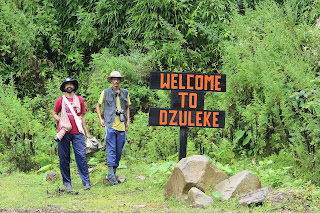 |
| On the way to Dzuleke |
A small white butterfly with dark spots sailed, a little away. Common species like Chocolate Pansy(Junonia iphita), Grass Yellows (Eurema sp.), etc. were seen along the way and so I took it granted for just a Common Pierrot(Castalius rosimon). It came down on a small pebble some meters away and I managed two-three distant snaps from where I stood. On keenly watching the snaps taken, anterior portion of that small butterfly seemed to be having some uncommon features with a bit of yellow colouration, rather distinct from Common Pierrot. When it moved forward just above the wet ground again and landed down, I followed slowly and steadily towards it,
 |
| Naga Great Spotted Blue |
 |
 |
 |
| Azure Sapphire |
Golden Sapphire |
Naga Sapphire |
 |
 |
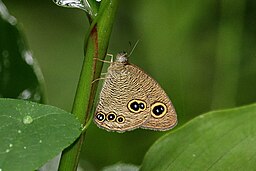 |
| Blue Peacock |
Newar Threering |
Himalayan Fivering |
Butterfly diversity of the North-Eastern states of India is wonderful. The variations in the microclimate, huge differences in the elevation of nearby places, and diversity of ecosystems may be the reasons. Merging of the Indian subcontinent with the South Asian region and the geographical barrier created by the Great Himalayas and resulting parallel evolution in the land-locked regions are also attributed to this abundance by the scientists. Every butterfly enthusiast in India is mesmerised with this opulent and amazing butterfly-bird diversity
 |
| Golden Sapphire |
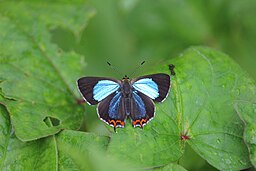 |
| Azure Sapphire |
 |
| Naga Sapphire |
 |
| Hill Jezebel |
 |
| Common Jester |
 |
| Punchinello |
 |
| Green Awlet |
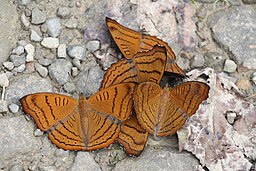 |
| Tabby |
 |
| Green Dragontail |
Three species of Sapphires were seen, some quenching nectar from the wild flowers while some others sitting with their bright wings open in the leaves of the bushes. All of them were small in size but having brightly coloured upper and underwings. Golden Sapphires (Heliophorus brahma) are with their bright golden yellowish underwings and crimson orange and dark upper wings. The second species Azure Sapphires (Heliophorus moorei) are with tempting luminous blue upper wings. The endemic Naga Sapphires (Heliophorus kohimensis), very less in number have upper wings with bright black colouration and undersides with deep yellow shades. Common windmill (Byasa polyeuctes), Asian Cabbage white (Pieris canidia), Large cabbage white (Pieris brassicae), Green Veined White (Pieris melete) , Rusty sailor (Neptis sappho) , Additional Lineblue (Prosotas pia), Pale Wanderer (Pareronia avatar), Forest Pierrot (Taraka hamada), Red Admiral (Vanessa indica), Blue Admiral (Kaniska canace), Himalayan Five-rings (Ypthima sakra), Yellow Spot Swift (Polytremis eltola) and Hill Jezebel (Delias belladonna) on a wet patch – all nectaring, flying, resting, basking and puddling by the waysides. Many of them gathered around large and brightly coloured Zinnia flowers. Some of them posed for our camera beautifully, while most others being agile and active were reluctant to be seated in front of the visitors from the faraway land.
A large number of Red Lacewings (Cethosia biblis) with their colourfully festooned wings posed perfectly before us and sound of innumerable clicks of three cameras filled the area for minutes. A group of brown and beautiful Tabby (Pseudergolis wedah) butterflies sat one above the other to proclaim their solidarity by the side of a small stream. Some Punchinello (Zemeros flegyas), Dark Judies (Abisara fylla) both from Riodinidae family, we couldn’t find anywhere in the South were another attraction on return. ( These were the names given from the mischievous puppet pairs in the British puppetry, ‘Punch and Judy’, Punch, the short form of Punchinello, the husband and Judy his wife. The etymology of
 |
| Spotted Jester caught by Spider |
A car from the village was arranged for our next day’s trip to Dzuleke by our host, Mr Khose. That remote village with its sparse population was around 10 km away from Khonoma. Our young and energetic driver was very happy to stop the vehicle wherever he saw some movements of butterflies amidst thickly grown bushes on the wayside. In the ubiquitous Lantana flowers growing abundantly in the open area, we could spot Chestnut Tiger (Parantica sita), Common Flash (Rapala nissa), Large Silverstripe (Argynnis childreni) and common species like Psyche (Leptosia nina), Common Grass Yellow (Eurema hecabe), Common Castor (Ariadne merione), Common Evening Brown(Melanitis leda) And two Swift species( Probably Straight Swift and Little Branded Swift). From the high growing jungles. Pappan Mash came running happily with the images of Common Jester (Symbrenthia lilaea) and Bluetail Jester (Symbrenthia niphanda). As it was drizzling we sped up to our destination. The find of the day, perhaps most valuable find of the trip. Naga Great Spotted Blue described at the beginning of the write-up was spotted just before reaching Dzuleke.
 |  |  |
| Tiger Hopper |
Spotted Jester |
Rusty Sailor |
 |  |  |
| Yellow Coster |
Yellow-spot Swift |
Dark Judy |
 |  |  |
| Veined Scrub Hopper |
Large Silverstripe |
Red Lacewing |
Dzuleke with its population of only 170, neither having mobile connectivity nor proper electricity was completely drenched in the rain, when our vehicle reached there. One or two home-stays were available there. Doors of the Eco-village committee office was closed and our driver managed to fetch a man driving further downwards the road. A guide, man from the Angami community, was an expert on local butterflies and birds. We followed him through a trekking path towards the forested area. But for our misfortune, the rain intensified and not a single butterfly was seen around. We had to terminate our trek. On return through the road, we went till the border of that village, where a small river was flowing with chocolate coloured water. We spend some time looking around. Tamil Songs were heard from the vicinity. The drivers of the truck engaged in the road
Some butterflies appear early in the morning and late in the evening. Our host called us for the black tea early the next morning. A Green Awlet (Burara vasutana) was also skipping just outside the coffee table. Leaving the tea on the table and fetching our camera from the room, everyone encircled the butterfly. It was jumping to and fro from the potted plants and ground. After breakfast, followed the same root we travelled the previous day, but this time on foot. Common species we recorded the previous days were plenty
throughout the way. We spent some time in the large playground of a school, covered with green grasses submerged in water. Beautiful Green Dragontail (Lamproptera meges) was sitting with open wings on the wet grasses. As and when we approached, it moved a little away. Though we were fortunate enough to have good glimpses of that butterfly on the ground we were not able to have good photos of the species. Other species of the day included Cruiser (Vindula erota), Common Birdwing (Troides helena), Blue Pansy (Junonia orithya), Metallic Cerulean(Jamides alecto), Six line blue (Nacaduba sp.)and Straight-banded Treebrown (Lethe verma). Less Rich Sailor (Neptis nashona)and Veined Scrub Hopper (Aeromachus stigmata), we encountered on our return made our lunch even late. |
 |
 |
| Straight-banded Treebrown |
Cabbage White |
Less Rich Sailer |
The Celerio car to Dimapur travelled slowly through the boulders and mud, rather a road, of the forest adjoining Mezoma winding up and down. But the spirit of butterflying in that unknown land was at its peak. Colours of the wings hitherto unknown, movements of the butterflies hitherto unseen were really an enthralling and memorable event. Unheard, unseen and untravelled far away lands in this mother earth itself are the first and last temptations of human life on earth- be it past, present or future.



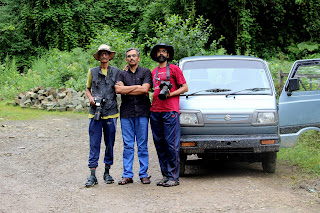
2 അഭിപ്രായങ്ങൾ:
Good
Outstanding
ഒരു അഭിപ്രായം പോസ്റ്റ് ചെയ്യൂ